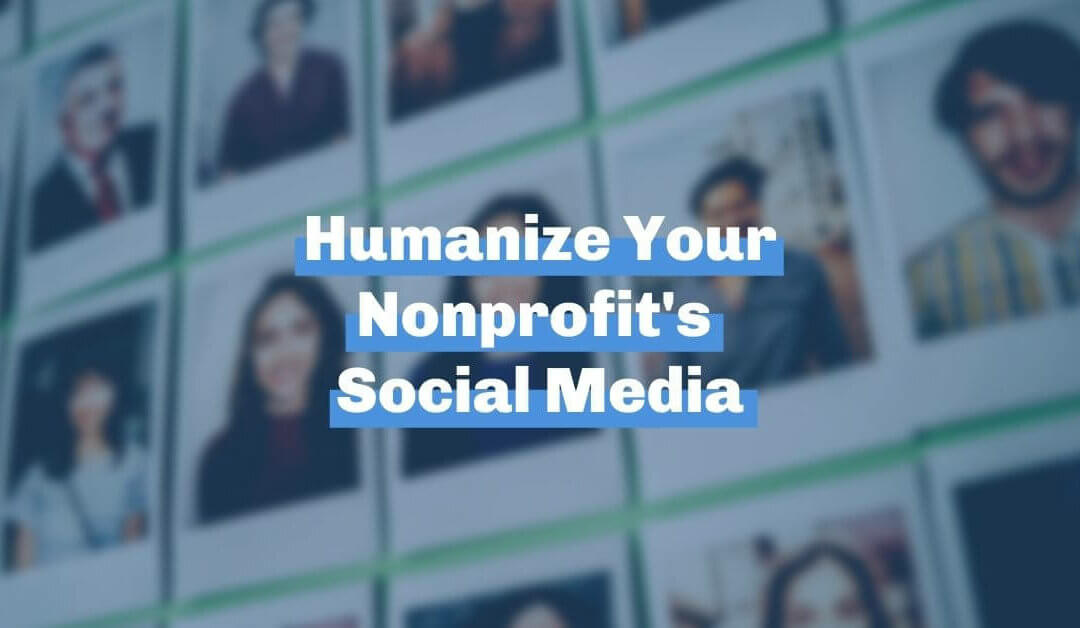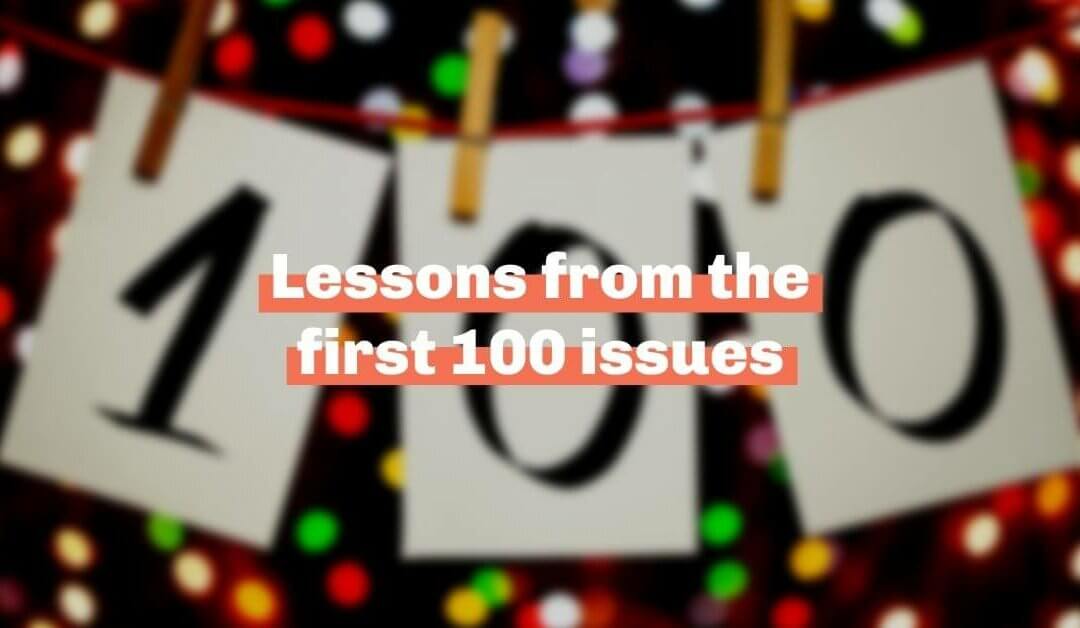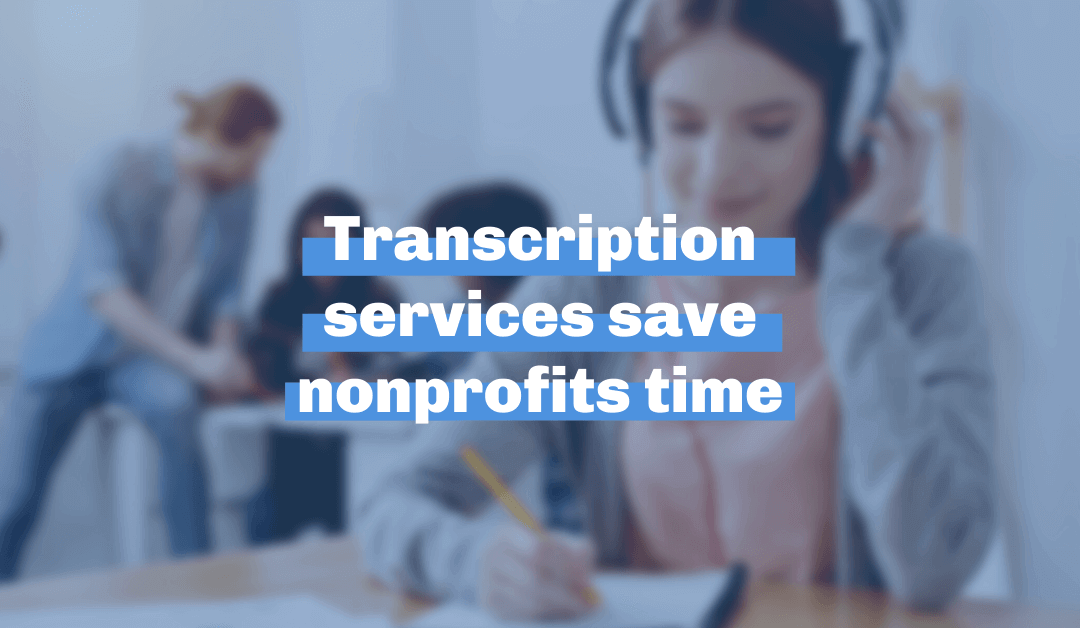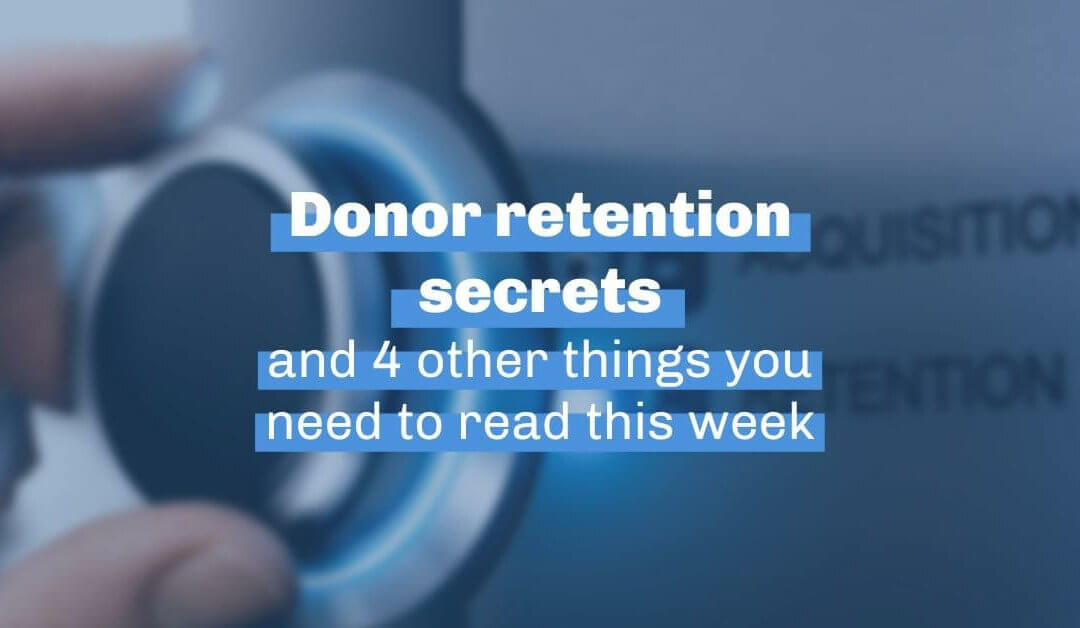
by Kerry Jones | May 3, 2022 | Copywriting, Marketing, Social Media
There’s a reason you listen to podcasts your friends recommend. There’s a reason that you ask to “speak to a representative” when you get an automated voicemail. There’s a reason your boss asks for references and your politicians run door-to-door campaigns:
People trust information when it comes from people.
It may seem obvious—nobody likes propaganda, impersonal video ads, or yelling monosyllabic commands at an answering machine. But nonprofit marketers underestimate the power of human voices for human messages, especially when it comes to their nonprofit’s social media strategy.
With the rise of the influencer economy, the ethical tilt to product marketing, and relationship-focused branding, it’s clear that the social media milieu is moving towards maximized personalization. Have you noticed how car commercials now sell family vacations instead of extra cup holders? Perhaps unsurprisingly, it sells to talk to customers like the people they are.
For a nonprofit organization, telling stories with honesty, personality, and humanity is critical in every step of your communication strategy. Here are the best ways to craft humanized social copy made by real people (you!) and for real people (your community!).
1. Match your marketing to your message
With so much going on in the day-to-day of a typical nonprofit, social media strategy can often fall to the wayside. Without a concerted effort, it’s easy for nonprofits to make their own (incredible, powerful, transformative) impact sound lifeless in a post. So what needs to change? What makes written words sound human?
- Write with emotion. How does your cause make you feel? Frustrated? Inspired? Overwhelmed? Hopeful? All of the above? Add a dose of that to your copy. Meet your reader in the world of emotion and channel the feelings they experience when learning about your work.
- Write to your audience. People speak differently to their boss than they do to their best friends—so know who you’re speaking to. What vocabulary is unique to them? What tones do they respond to?
- Write with kindness toward imperfection. Sometimes we forget to donate. Sometimes we are uninformed about issues. Sometimes we recycle incorrectly. Make sure your reader knows you aren’t perfect, either; they’ll appreciate your kindness and feel open to your call to action.
Looking for an example? Girls Computing League does a great job bringing their unique voice to their Instagram. Working to bridge the gender gap in STEM fields, they provide scholarships to girls in STEM and invest resources for girls in low-income schools.
Their account vibrates with life by speaking directly to girl coders and the people who support them. Posts include TikToks using popular sounds to talk about being underestimated by men in their field, posts on STEM women in history, or educational posts on writing a professional email. Their excitement about women in STEM industries is palpable in the voice of frustration, sass, and encouragement in each post.
2. Promote messages that vibe with your values
Want people to recognize your name? Start with helping them recognize your values.
Whether you care about climate justice, ending world hunger, or arts programs in schools, the good news is you are not the only one who cares. Reels, stories, and infographics are great tools for cross-promotion with the people, organizations, and brands fighting the same fight.
Repost your amazing donors’ content. The Karam Foundation reposted a story from a donor who supported them with a marathon fundraiser. St. Jude pinned a video on their TikTok celebrating accounts that link to their fundraising page in their bio. Appreciating current donors? Check. Demonstrating support to new donors? Double-check.
Link to organizations doing similar work. Urban Indigenous Collective cares about supporting Indigenous people, so this post with links to the American Indian College Fund was a great way to demonstrate their values. It establishes their account as a place for UIC content, but also as a bulletin board for organizations supporting Indigenous people.
Promote your partners. Are local businesses helping you with an upcoming event? Do companies donate to your cause with the purchase of select items? Girls Inc. benefits from purchases made at Macy’s and Thinx and celebrates these partnerships with posts like this.
3. Show us what success looks like
Repeat donors feel connected to the story of your impact—and they want to continue being a part of it. Compared to emails and newsletters, social media tends to be more visual and interactive—so it’s a great place to make your impact more visual and interactive, too!
Mercy Corps posted about a Ukrainian refugee family’s journey and the medical supplies, food, cash, and support they were able to give them. Notably, this post doesn’t use pity to tell their story in an undignified way but instead shows the family’s journey and the agency they display as they plan their next steps. Kudos to you, Mercy Corps.
Organizations like Hand on Heart WWP, which serves people experiencing homelessness, also do a great job of showing their impact. It’s not respectful to take pictures of vulnerable unhoused people, so Hand on Heart posts photos of large piles of sleeping bag donations and care packages instead. Other houseless aid groups often lean on pretty infographics of their impact stats, but they can feel hollow, making donations feel less tangible. Hand on Heart owes its social media success to videos like this that put donors in the room with the amazing resources they purchase.
4. Tell us what happens behind the scenes
We love the design and polish you put into your infographics, your videos, and your curated color scheme. But sometimes, your produced facade hides your real story. For donors who want to know that your nonprofit is legit, trustworthy, and effective, try these posts to help pull back the curtain.
- Give us a tour of your facility. Show off your youth center, your animal shelter, your school, or your office! Even if it’s messy or busy or chaotic, donors want to see where the magic happens. The Cattery cat shelter has a beautiful TikTok tour of their facility that shows off all the ways they provide for their furry friends.
- Introduce your team. Whether through a video interview, a post, a story, or a TikTok, donors want to know your volunteer coordinators, your accountants, and your CEO. You can talk about why they are special to your operations (“Diana is the master of managing receipts”) or what they do on the side (“Diana’s two dogs, Lucky and Frankie, have been with her for ten years. It’s no coincidence she is so passionate about animal rights.”) If you have confidence in your team’s work, donors will too. This ”meet our team” post from Site Design Group does a great job of introducing their staff.
- Introduce your board members. If your website’s board member bios feel a little tired, try this approach. Post about your board members in action: photos of them with the family they mention in their bio, working with your volunteer team, or answering fun questions relevant to your mission. Massachusetts Avenue Project has creative “Meet the Board” posts on their Facebook page.
- Product tour. If your nonprofit donates products like hygiene care packages or boxes of books, show donors what they look like! Tell us about your materials, your delivery style, and what makes your products valuable and unique. Days for Girls, a menstrual health NGO, uses the highlight feature on Instagram to explain the features of the DFG pad and what comes in their full kit.
- Day in the life. TikTok “day-in-the-life” videos are really popular right now—and they can be great for a nonprofit to show off how you spend your time and where donations go. What does a day in the life look like for a community organizer? A youth leadership camp counselor? An animal shelter staff worker? What would surprise people about the work you do all day? Community Action Partnership has a great day-in-the-life TikTok showcasing how their Health Coordinators support their community. Check out a few nonprofits we love following on TikTok.
- Sneak peeks as you prep for events. If you want to boost excitement for an upcoming event, “sneak peek” posts are a great way to drum up anticipation. If you’ve got an auction at your gala, show off the prizes people can bid on. If you have a tree planting event for Earth Day, show off the saplings that need a new home! Give donors the inside scoop about how your event space is looking, how excited your staff is, and all the fun bonuses they can look forward to. United Way of Greater Baytown Area made a Facebook post leading up to their Volunteer Appreciation Awards to get people excited.
It’s not hard to be human, but it does take intentionality.
Humanizing your nonprofit’s social media doesn’t have to be hard, but it does take effort. Luckily, it’s worth it—both to build community and foster ongoing support. Speaking to current and prospective donors like real people will make it easier to create and foster long-term relationships, connect with your supporters, and spark even more impact for your mission! Win win win.

by Allison Kooser | Dec 16, 2021 | +Good Newsletter, The Intro
Welcome to the 100th edition of +good! (We know—we can hardly believe it, either!)
We’ve been sharing our thoughts on marketing, fundraising, leadership, team dynamics, and keeping our work lives fun for almost two years. We’ve compiled the tools and articles that inspire us. And we’ve had the opportunity to connect with so many extraordinary nonprofit leaders like you!
(You’re awesome, by the way!)
Over the course of 100 editions, we’ve learned a few things—lessons that, yes, apply to an email newsletter but also apply to so many pieces of our work.
Having a creative outlet of your own is good for you.
Writing these intros is one of the best parts of my week. In a schedule full of writing for other people, having a dedicated hour to put pen to paper about the things I am personally thinking about is such a gift. Plus, it’s a great way to process all of the content I’m consuming regularly. And you don’t need a newsletter to do this—open a notebook or a doc and get started!
It’s ok to say no.
There have been weeks when the newsletter felt like one thing too many, so you know what we did? We skipped an issue. Yep. We just decided that it wasn’t worth the added stress. This ability to own our work (instead of letting our work own us) is one of the best parts of being our own bosses. And hopefully, you feel this same kind of freedom in some of your assignments!
You can be wrong.
Curating a list of marketing tips and tricks every week has been a learning experience for our entire team. And one of the best parts of pulling together the meat of the newsletter is realizing that we can (and should) challenge our way of thinking, too. Constant learning and curiosity are core tenets of our business—and that means we’re constantly rethinking the way we do things.
Community is what it’s all about.
Hearing from you, our awesome readers, is one of the best parts of writing this newsletter. Knowing that our messages resonate (or that you’ve finally taken control of your calendar, started canceling meetings, or stepped up your leadership game) brings us so much joy. In fact, it’s why we do this thing in the first place. You’re our why—and we love getting to know you!
Thank you for reading along with us for 100 issues—and here’s to the next 100 ahead of us! If there are things you’d like to hear more about (or less about!) please let us know by replying to this email. We are always looking for inspiration, and we know you have a ton of it!
Until then, know that you are doing great, hard, powerful work. Work that makes a difference. Work that is making the world better. We are cheering for you and honored to be in your inbox!
In the spirit of saying no and protecting our schedules, we’re taking the next two weeks off from the newsletter to enjoy time with our families. Hope you have a fantastic holiday—and we’ll see you in 2022!

by Kerry Jones | Nov 8, 2021 | Work Smarter
Enough is enough. This has gone on for too long, nonprofits. You know what this is about.
Your typing fingers work too hard. They need a break.
We know nonprofit work means plenty of hours behind a computer, and that often feels like an exhausting bummer. But we don’t make the rules. We don’t even like the rules. Nonetheless, nonprofits require communication and dynamic web content. That used to mean a lot of typing. But those fingers need to rest.
Enter: transcription services. Save time (and effort) creating content, and support your nonprofit’s communication plan with free and low-cost tools available online.
What are transcription services?
Transcription services are tools (driven by either skilled professionals or magical software) that turn audio data into written text. They are able to distinguish between speakers, languages, and words, and can use real-time audio data or recordings. Most software uses AI to accurately transcribe audio, but for slightly more money, you can pay professionals trained in shorthand.
Why transcribe my audio?
Transcription services not only save you time, but they also save your audience time. Imagine you’re in a hurry and need to catch a train. Would you rather listen to an announcer read a list of all scheduled trains, or read it yourself? The same goes for your audience.
Visual information is faster to take in than audio information. This means displaying text—even with your video or audio content—saves time spent reading.
Visual text can also broaden the audience your content can reach. Whether users are visual learners or have difficulty hearing, the transcribed text demonstrates you made content with them in mind. Plus, adding transcribed text to your content makes it easier for search engines to find.
Compared to audio, written text is also easier to share virtually—which comes in handy for nonprofits with remote workers.
I’m sold. But how exactly can my nonprofit use transcription services to save time?
We’re glad you asked. Transcription services have lots of versatile uses, so we put together a list of six ways they can save time and bring new life to your audio content.
1. Turn a public conference call into a blog post.
It’s 2021 and Zoom fatigue is real, so your donors may not accept your public conference call invites. No problem! Just transcribe the meeting, and distill the transcript into the most useful information. Whether that’s your success metrics or your frequently asked questions, you have content ready to repurpose for your blog.
2. Turn a video interview into a blog post.
Video interviews are great visual elements to liven up your website or boost your Youtube channel. But once again, the user in a hurry doesn’t have time to fast-forward through them. So why not turn that interview into a blog post? Post the video at the top of your blog and the transcript below. That way, you can keep the interview long while accommodating both the reader in a rush and the viewer with time to kill.
3. Turn a virtual interview with an expert into social media content.
Expert testimonials are great at demonstrating the efficacy of your nonprofit or diving into specific program areas. With transcription software, you can interview experts virtually and plug their testimonials into your content. Expert quotes about your area of service make great how-to infographics for Instagram, compelling posts for Twitter, and intriguing blog headlines. You can even add them to the opening pages of your Annual Report to drive home your work’s success.
4. Turn personal testimonials into quotes for your landing page.
Donors and potential donors love to see heartwarming proof of your impact. If you have testimonials or interviews from those you serve, ask for permission to use those transcripts as enlarged quotes on your landing page. Written quotes on a site’s landing page can be both visually striking, and emotionally gripping—basically, marketing gold. And they provide the added benefit of anonymity for those who want to share their experiences without sharing their image.
5. Turn board member interviews into an ‘About Our Team’ page.
If your board members are central to your operations, maybe they deserve a bit of real estate on your website! But let’s skip the overworked paragraphs and make this easy. Ask them each a few questions about their work and motivation, cut the extra out of the transcript, and you have the body of an ‘About’ page. If you want to stretch those interviews for more content, extend the interviews and create a blog series on your board members!
6. Transcribe meetings for virtual or absent team members.
In a world of remote and hybrid work models, not everyone will attend every meeting. Instead of assigning someone to take minutes and email the file later, use a transcription service to capture what was said. Compared to frantic meeting notes with bullet points and no context, your transcript can capture the points made as speakers make them. Plus, you have the ability to go back through the transcript and search for keywords if there was something important you missed.
Easy-to-use Transcription Services
There are a lot of fantastic transcription services to choose from. Best of all, many of them are free or available at a low cost.
For transcribing software that uses AI, we recommend Happy Scribe or Otter. Otter is excellent for live transcriptions and adding notes and images. We love Happy Scribe for video captions, and it’s also great for transcribing across languages.
For transcription services that use real-life professional humans to improve accuracy, we recommend Rev. Rev files are shareable with Dropbox and Google Drive; their team transcribes audio files overnight and you don’t need to edit mistakes.
Why not make your work easier?
Your time is valuable to us. (And so is the well-being of your tired fingers!) Make things easier for yourself and find the transcription service that works best for you.

by Ian Haisley | May 21, 2021 | +Good Newsletter
1. The magic 🌟 of social proof.
Remember that movie you almost saw, but the reviews were so bad? Remember that restaurant you almost skipped, but the reviews were so great? Social proof is just good reviews transformed into free advertising. Learn how to take your clients’ testimonials, mentions, and case studies and use them to build trust in your services.
Turn your donors into advocates. [via unbounce]
2. The algorithms, 📈 they are a-changin’.
Next month, Google plans to release its Google Page Experience update, along with some additional SEO tools. These new features will ensure that websites provide the best experience to searchers, whether they are using a mobile, desktop, or tablet device. Preparing for a new update can be a challenge, but there are simple steps you can take now to get ahead of the algorithm changes and avoid declining traffic.
Get prepared for the update. [via Neil Patel]
3. Why do 📩 emails go to spam?
The most frustrating thing: putting so much time into your emails just to have them end up in a spam folder alongside ads and scams? You’re better than that! You deserve the inbox! Luckily, there is something you can do. Learn about 12 common mistakes we all make that land us in our readers’ spam folders—and get your emails where they need to be!
Get into the inbox. [via GetResponse]
4. Don’t waste good content. ♻️ Repurpose it!
Listen, content creators: we get it. You’re swamped with assignments. But what if you could re-use content instead of re-inventing the wheel each time you post? A few simple content strategy changes could save your heavy workload and boost web traffic on content that already works! Don’t let a good thing to go to waste—learn to build your customer base by repurposing content.
Reduce, reuse, recycle your content. [via Content Marketing Institute]
5. Unlock 🔓 Facebook’s full potential.
While LinkedIn may have cornered the market for professional social networking, Facebook holds valuable networking potential, too—if you can find and join the right groups. Check out this extensive list of the most active, supportive, and useful groups for marketers on Facebook. After joining the right group, you’ll be able to ask questions, learn best practices for growing and building your organization, and connect with your fellow industry professionals.
Join your peers on Facebook. [via Wild Apricot]
This issue of +good was written and produced by Allison Kooser, Ian Haisley, Sydney Bartlett, Kerry Jones, Lindsey Lincoln, and Katie Powers.

by Ian Haisley | May 14, 2021 | +Good Newsletter
1. Keeping your donors is 👌 easier than it seems.
Tired of chasing lost donors? You aren’t alone. Nonprofit donor retention rates have been below 50% for the past decade. Learn what you can do to keep your donors’ eyes off the exit sign and treat them like friends we will see again soon.
Learn 5 secret nonprofit donor retention strategies. [via clarification]
2. Hit 🔃 refresh on your messaging.
You’re clever, funny, and honest. You know it, we know it, and your audience should know it, too! Keep your message stays relevant and fresh with helpful tips like using different voices from your staff, cracking a joke here and there, and sharing an opinion.
Don’t be afraid to try something new. [via Nonprofit Marketing Guide]
3. Adapt your Facebook campaigns for 📱 iOS 14.
In addition to new emojis, the new iOS 14 means updated privacy and data use regulations that will impact Facebook campaign performance. You may have already noticed shifts in Ads Manager — and more changes are certainly incoming! Nervous about adapting to the new normal? Here are some tips to navigate the update.
How iOS 14 will impact your Facebook ad campaigns. [via Portent]
4. Create evergreen 🌱 content that stays fresh for years.
If you’re looking to create marketing materials that will work for the long haul, lean into the art of evergreen content. Answer the questions your audience asks most, think about what people search, and craft stories that will never go out of style.
Evergreen doesn’t have an expiration date. [via Neil Patel]
5. Keep your audience 🗓 on time.
If you’re hosting a virtual event on a platform like Zoom or Google Meets, the Add to Calendar app will help ensure no one misses out. This handy tool allows you to create links that will let your audience quickly save your events onto various calendars and get an automatic notification as it’s about to start. You can create links and event reminder buttons for Google Calendar, Outlook, Microsoft Office 365, and Yahoo! Calendar, which is particularly helpful when you have audience members working across multiple platforms.
Add to calendar. [via Labnol]
This issue of +good was written and produced by Allison Kooser, Ian Haisley, Sydney Bartlett, Kerry Jones, Lindsey Lincoln, and Katie Powers.





